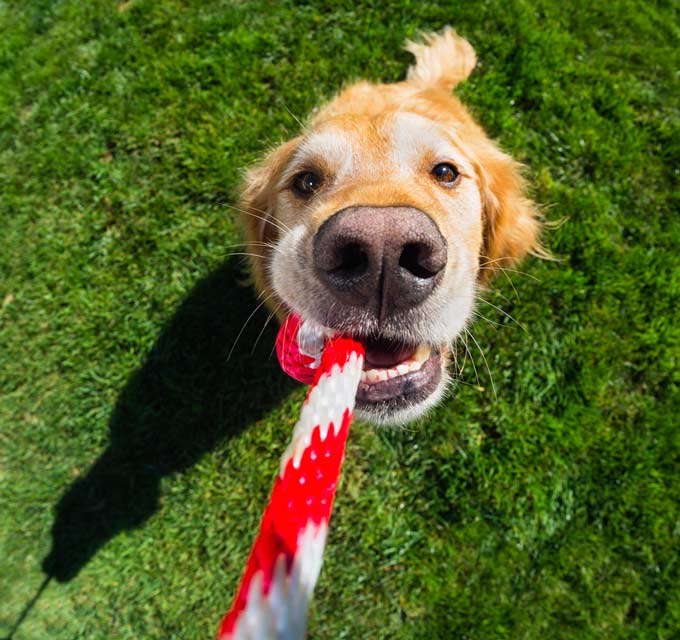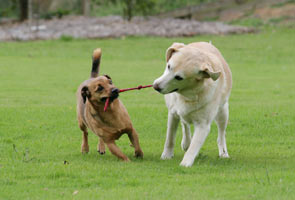Tug Of War

Chances are good that your dog loves to play tug-of-war. But is this game good or bad for dogs? Debate exists as to whether tug-of-war is a healthy—or even safe—activity for dogs. Will it cause aggression? Can it cause physical harm? Or is it safe to say that all's fair in tug-of-war?
Why Dogs Love Tug-of-War
For thousands of years, dogs evolved to help humans by performing jobs. These jobs included hunting, and dogs hunted even before they were domesticated. Tug-of-war may be beloved by many dogs because it mimics grabbing and shaking prey. In today's world, jobs have mostly been taken away from our canine friends not through the process of evolution but through the rapid change in human civilization. They don't need to hunt for us or for themselves anymore. Dogs are mostly expected to be pets now. However, they still have the same drives that they always did and can develop negative behaviors if those aren't met.
The Benefits of Tug-of-War
- It's a great form of exercise.
- Tug-of-war is a way to bond with your dog.
- Tug is a great way to leave your dog happy and exhausted, decreasing the chances of boredom or stress-related negative behaviors.
- The game allows a chance for rough-housing, with ground rules set and observed.
- Dogs love tug-of-war so much that it can be used as positive reinforcement during training sessions. When you are teaching your dog to fetch, sit, or come, you can use a short game of tug-of-war to reward him for responding properly.
- If your dog uses his teeth to mouth at you, tug-of-war can be used as a redirection of that behavior. This type of positive reinforcement can help show your dog that it's appropriate to chew on the toy but not on your arm.
- Tug-of-war, because it is very exciting, can help your dog learn to obey your commands, even under extremely stimulating conditions. Learning to drop the tug toy when you ask him to can translate to your dog knowing how to obey you during other exciting situations. This can sometimes be life-saving.
- Tug-of-war games can increase confidence in a timid dog. If your dog seems hesitant to play tug, you can help him learn to enjoy it.
Is Tug-of-War Safe?
Despite all of the wonderful benefits that most dogs enjoy from tug-of-war, the game has a bit of a negative reputation. Many people think that it can lead to the development of aggression or dominance problems in dogs. Below are some instances where the game is not safe to play:
- Dogs with a previous history of aggression should never be allowed to play tug. Tug-of-war, for these dogs, can trigger dominance, and the dog may become truly aggressive toward you (see box, below). If you have a dog that has behaved aggressively, talk with your veterinarian about seeing a behaviorist.
- Some dogs shouldn't play tug-of-war because of dental concerns. Puppies should not be allowed to play tug-of-war because their teeth and jaws are still growing. Tugging on their mouths and teeth at this time may cause malocclusions. Dentition is usually completely developed by eight to nine months of age. Even mature dogs have been known to need extractions and root canals from overly-vigorous tugging. Care should always be taken to avoid super-strenuous pulling.
- Dogs that suffer from arthritis should not play tug. Because tug-of-war is a full-body game, dogs with arthritis and other orthopedic problems are at increased risk of injury.
- People should never tug with an up and down movement, but only from side to side. Up and down tugging can lead to spinal injury for your dog.
- Take your dog's size and weight into consideration when playing tug-of-war. Adjust your intensity to fit your particular dog. A smaller, lighter dog shouldn't be tugged on as vigorously as a larger, heavier dog can be.
Outside of these considerations, most experts agree that playing tug-of-war is fine for dogs. There is no evidence that it can cause a non-aggressive dog to become aggressive. However, there are rules to the game that should always be observed, to increase its safety even further.
Tug-of-War Rules
-
The tug-of-war toy:
- Use a toy that is long enough that your dog won't accidentally grab your hand with his teeth when he is readjusting his grip. Also make sure that it is comfortable for you to hold.
- Use the chosen toy ONLY for tug-of-war, and put it away when the game is done. This way, your dog knows that he is only allowed to play tug when that toy is out.
-
You must start and end the game.
- Your dog needs to understand that humans should initiate tug-of-war games and decide when they are over.
- Have your dog sit calmly before you start the game.
- Don't allow your dog to jump on you to try and get the tug toy or to grab at you or your clothes with his mouth to try and initiate a game.
- You need to offer the toy to your dog and start the game, and he needs to sit calmly, without lunging, until you do. If your dog lunges for the toy, put it away for a minute before getting it out again.
Signs of aggressive behavior
- Stiff, still body
- Tail raised high
- Steady, unblinking eye contact
- Snarling
- Low growl
- Hackles raised
- Face muscles that are taut instead of happy
The appearance of any of these signs during play indicates that it's no longer just fun and games. Promptly drop the toy and walk away. Do not attempt to correct, yell at, or hit a dog that turns aggressive during play. Do not attempt to gain possession of the toy. You could get hurt. Consult your veterinarian for specific advice on managing your dog's aggression.
-
Your dog must give up the tug toy any time you command it.
- Teach your dog a "leave it," "drop it," or "give it" command. You can do this by using the phrase, then showing your dog a treat. Give him the treat as soon as he drops the toy. You may need to have several training sessions to learn the command before you begin playing tug-of-war. (For more tips on teaching the "drop it" command, see this article.)
- Whenever you are playing tug-of-war, give the "drop it" command periodically to reinforce that you are in control of the game. Have your dog sit again before beginning a new game.
-
Children should never be allowed to play tug-of-war with dogs.
- Children may be less able to set limits with the dog. They may also miss the signs that the game has gone too far.
- A child's smaller size and weight puts them at a disadvantage, and this could lead to severe injury.
- The same holds true for frail or elderly people who could suffer serious harm from a dog bite or just from being yanked over.
- If your dog's teeth touch you, end the game for a minute. Say a phrase, like "Uh-oh," take the toy away, and stop the game for a minute. Your dog will learn that the fun ends when his teeth venture where they shouldn't.
- If you are uncomfortable at any time or if your dog shows any signs of aggression (see box), drop the toy and walk away immediately. Never attempt to correct a dog that is showing aggression by yelling, trying to get the toy away from him, or hitting him. This could escalate quickly and you could be seriously injured. Your dog may be one of the few that shouldn't play tug-of-war. Contact your veterinarian to discuss your dog's behavior.
Should You Ever Let Your Dog Win the Tug-of-War Game?
The answer of whether you should ever let your dog win at tug-of-war is not agreed upon by experts. Some say you should never let your dog win, but others say that allowing him to win by giving him possession of the toy sometimes can help build trust between you and your dog. If your dog is a good sport at tug-of-war and will reliably give you the tug toy on command, there is probably little harm to letting him win sometimes.
Some Dogs like to Play Tug-of-War with Each Other

Dogs that get along well may be able to play tug-of-war together. If you have dogs that tend to get into fights, they should not play tug. Dogs play tug-of-war differently with each other than they do with humans. The whole goal for each dog when they are playing with other dogs is to gain possession of the toy. There may be some good-natured snarling and growling when dogs play with one another.
You can usually tell if your dogs are truly fighting because their bodies are stiff and their faces do not look happy. Their tails are not wagging, and their bodies are not wiggling and hopping good-naturedly. If your dogs do begin fighting, do not get in between them. Call your dogs to you. Dogs that are trained to come reliably when they are called will respond even in an exciting situation.
Some Dogs Like to Play Tug-of-War Alone
Do you want your dog to experience the benefits of a great game of tug-of-war but you have back, arm, or shoulder soreness that would be aggravated by it? Do you enjoy a great game of tug but you get tired before your dog does? There's a great option available for you, too. The Tether Tug Dog Toy is a great way for your dog to play Tug-of-War to his heart's content. For supervised play only.
References
Miller, P. (2008, September). Tug O' War Is a Fun Game To Play With Your Dog. Retrieved from The Whole Dog Journal: http://www.whole-dog-journal.com/issues/11_9/features/Fun-Games-To-Play-With-Your-Dog_16059-1.html
You May Also Like These Articles:
Keeping Your Dog Active While You're Away
Canine Body Language: What Is Your Dog Saying?
Why Does My Dog Drink from the Toilet?
Minding Your P's and Q's At The Dog Park
Disclaimer: This website is not intended to replace professional consultation, diagnosis, or treatment by a licensed veterinarian. If you require any veterinary related advice, contact your veterinarian promptly. Information at DogHealth.com is exclusively of a general reference nature. Do not disregard veterinary advice or delay treatment as a result of accessing information at this site. Just Answer is an external service not affiliated with DogHealth.com.
Notice: Ask-a-Vet is an affiliated service for those who wish to speak with a veterinary professional about their pet's specific condition. Initially, a bot will ask questions to determine the general nature of your concern. Then, you will be transferred to a human. There is a charge for the service if you choose to connect to a veterinarian. Ask-a-Vet is not manned by the staff or owners of DogHealth.com, and the advice given should not delay or replace a visit to your veterinarian.



